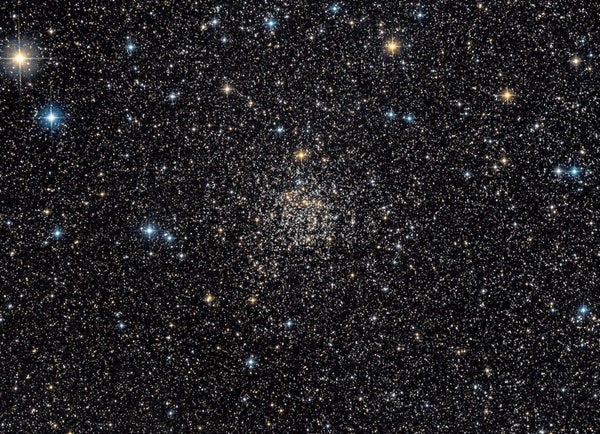Despite peacefully floating in the night sky, stars are not docile creatures. They’re churning caldrons of roiling plasma stirred by countless nuclear explosions within.
Scientists know that such stellar nuclear fusion is responsible for creating many heavy elements necessary for life in the universe, such as carbon, oxygen, and nitrogen. But what’s less understood is how these elements escape their stars and leach out into the universe — a rather major step in the development of life itself.
Now, new research published July 6 in Nature Astronomy suggests some of the basic building blocks of life are dispersed through the universe as low-mass stars take their dying breaths, metamorphosing into stellar remnants known as white dwarfs. The clue to this discovery comes from the realization that some small stars are leaving behind corpses that are more massive than expected.
“Understanding of the processes by which elements heavier than hydrogen and helium are dispersed to either a star’s immediate environment or to the wider universe — rather than being trapped in dense remnant cores — is still limited,” Jeffery Cummings, an associate research scientist at John Hopkins and co-author of the study, tells Astronomy. “But we are now able to far more reliably confirm the processes with which carbon is dispersed to galaxies through evolving stars.”
The international team of researchers chose to specifically focus on carbon because the origins of this life-enabling element — as opposed to others like oxygen and nitrogen — are not nearly as well understood.
“We already know that most of the nitrogen in Earth’s atmosphere arose in stars that did not explode, whereas the oxygen you breathe came from stars that did explode,” coauthor Enrico Ramirez-Ruiz, professor at the University of California, Santa Cruz, explains to Astronomy. “Carbon’s origin is less clear; some studies place its birth in larger stars that exploded, while other studies say just the opposite.”

What we can learn from the life cycles of stars? Astronomy’s free downloadable eBook, Stars: The galaxy’s building blocks contains everything you need to know about how stars live, die, and change their galactic homes over time.
One possibility is that supernovae are responsible for flinging most carbon into interstellar space. But the lingering problem with this scenario is that high-mass stars — the progenitors of supernovae — are relatively rare compared to how much carbon astronomers see in the cosmos.
So, perhaps low-mass stars, which end their lives as white dwarfs rather than neutron stars or black holes, also get in on the cosmic carbon fight. Indeed, some existing theories suggest that puny stars sport powerful stellar winds that blow away their outer envelopes as they transform into white dwarfs. But so far, observations have failed to fully back up that claim. This new research, however, might be a step in the right direction.
A kink in the initial-final mass relationship
The astronomers examined data collected by the W. M Keck Observatory in Hawaii throughout the summer of 2018. Specifically, they focused on analyzing white dwarf stars located in open clusters spread throughout the Milky Way.
“Our research focused on using white dwarfs, the exposed cores of dead stars, to better understand how stars evolve and die,” says Cummings. “Connecting these white dwarfs to the characteristics of the stars that died to form them is the most direct way to observe the parameters of these stars’ cores at the final stages of their lives.”
The researchers then traced the evolution of the white dwarfs back in time, deriving their initial masses with the help of an important relationship in astrophysics, the initial-final mass relation (IFMR), which, despite its ubiquity, still has its quirks. “The initial–final mass relation connects the mass of a white dwarf with the mass of its progenitor in the main sequence,” says Ramirez-Ruiz. “By understanding this relationship, we are able to put stringent constraints on the carbon-containing mass that was ejected during the evolution of the star.”
Generally speaking, the more massive a progenitor star, the more massive its remnant. But the team discovered an apparent ‘kink’ in that relationship. Stars starting with about 1.8 to 1.9 times the mass of the Sun seem to be leaving behind larger-than-expected corpses.
The break in the IFMR was noticed independently by both Cummings and the study’s lead author, Paola Marigo, a theoretical astrophysicist at the University of Padova in Italy. Importantly, Cummings found the kink through observations, while Marigo uncovered it in her theoretical modeling.
Pumped up with carbon
According to the researchers, the fact that stars with just under two solar masses seem to produce plus-sized white dwarfs suggests these stars were still forging carbon in the final stages of their lives. This carbon was then passed into the interstellar medium by stellar winds, which is a far more gentle process than being violently propelled by supernova shock waves. This revelation places a constraint on the evolution of low-mass stars, as well as how they chemically enrich their surroundings.
This new ‘low-mass star theory’ of chemical enrichment doesn’t so much compete with previous ideas as it does bolster them. It’s not that low-mass stars are solely responsible for enriching their host galaxies with carbon, but they do work with their bulkier counterparts to get it done.
“There is ample evidence that both exploding massive stars and low-mass stars contribute to the production and distribution of carbon in the universe,” says Ramirez-Ruiz. “This is evident by looking at the fossil stellar record in the Milky Way.” Ramirez-Ruiz goes on to suggest that massive stars could contribute more to carbon-enrichment early on, while low-mass stars might inject more carbon into galaxies at later times. After all, smaller stars live much longer than larger stars.
“With all of the complex processing that can occur in astronomy, the production of elements is never an ‘only A or only B’ type of process,” Cummings stresses. “Both processes are likely major contributors, and our work does not rule out the contribution of more massive stars and their supernovae.”
However, one thing is for sure, there is still much to learn about low-mass stars and their evolution, as well as the role they play in the chemical enrichment of their host galaxies. Cummings says astronomers need to intensely study stars ranging from about one to two times the mass of the Sun, as well as the white dwarf remnants they leave behind.
“Whilst I do hope to be involved at some level in future work of this nature,” the researcher says, “I am just as excited about the prospect of this current study inspiring a younger astronomer to take the lead.”











